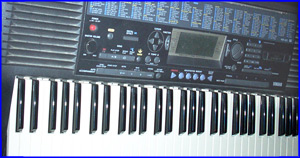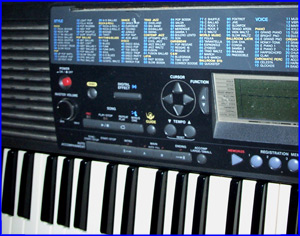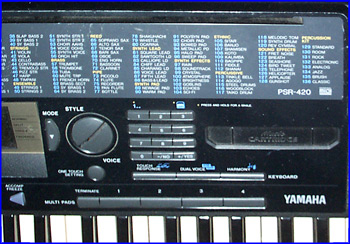At North Suburban Hammond Organ Service, we use MIDI primarily in the additional keyboards that we use if we produce musical programs or recordings when we need extra sounds that are not either directly available from a Hammond organ, or when we want more accurate instrumental imitations than those obtainable from the electronic organ. In this instance, we are using one of the simplest MIDI applications. The keyboard generates standard MIDI information, and these keyboards also contain on-board synthesizers where the MIDI instructions that result from the playing keys are directly converted to instrument sounds which we subsequently send to the same speaker system that serves the Hammond organ as that yields a good final result. This of course is a "real-time" application where we are hearing what we play as we actually play it.

Figure 1. On a stand to the right of the Hammond console is a MIDI keyboard, in this case a Yamaha PSR-420. Strictly speaking, a MIDI keyboard is simply a keyboard which generates MIDI signals which get sent to other MIDI equipment. The PSR-420 also contains an on-board synthesizer which receives the MIDI instructions from the keyboard and generates the appropriate instrument sounds. However, it has the capability of outputing MIDI information directly for the subsequent use in other MIDI applications.

Figures 2, 3, and 4. Overall and specific views of the keyboard showing various controls. Across the top is a complete list (although hard to read in these pictures) of all of the instrumental effects and also various rhythms which are preprogrammed into the unit along with their two- or three-digit location or selection numbers. The keyboard does contain a dedicated computer of sorts which handles many of these functions, however it is possible to connect it, via standard MIDI cables to a separate computer which greatly enhances the possibilities. For our live performances at the NSHOS monthly meetings, we use it only as an extra source of real-time, directly-played instrument sounds.


Most often, we use the MIDI keyboard as a piano to compliment the Hammond's sounds with a piano solo, however, we also have used it as a solo trumpet, trombone, chimes, vibes, and even a rhythm section as well as a guitar. It is possible to combine MIDI voices and effects to create different effects and it's also possible to play sounds at different pitch levels just as we do with electronic organs.
In addition to this, however, we have also used MIDI for enhancing some recordings that we have made of popular songs where we want to create the effect of a Hammond organ playing along with a trio or a combo. In these instances, we use MIDI keyboards in conjunction with a computer having special software for the task. This allows us to play solos and accompaniments as well as drum tracks independently with a great deal of control over many aspects of all of these different instrument sounds and then play back the entire arrangement while playing a Hammond in real time to our orchestral creation while simultaneously recording the entire performance.
In this situation, we may have the MIDI keyboard playing one or more synthesizers in the computer's sound card, a different keyboard or several of these together. On the next page is a screen shot of the computer monitor showing one example of MIDI software and one form that a song can take. Notice that the computer screen shows a small, vertical keyboard at the left, and individual notes as various length lines on a graph. As such it is a little bit reminiscent of a player piano roll.
Previous Page Page 2. Next page